Is it true? Is there such a thing as a piece of equipment that actually sells itself? According to several dealers who are having success with high-speed tillage, this is about as close as it can get.
High-speed discs have been around for many years, so most growers know what they are and what they’re supposed to do. In fact, many are already leaning in that direction when visiting a dealer. At the same time, there are plenty of growers who have heard about high-speed discs but aren’t completely convinced that the equipment can perform as advertised. As the old saying goes, “Seeing is believing.”
“People don’t believe what a high-speed disc can do until they run one,” says Travis Grauer, owner of Grauer Repair Service in Sheridan, Ore. “A high-speed disc is one of those implements that, once you get it in the field and see what it can do, you only ask yourself, ‘Why don’t I already own one?’”
Takeaways
- Identify what the customer is actually looking to accomplish to determine if a VT tool or high-speed disc is a better high-speed solution.
- Confirm that the customer has the tractor/horsepower necessary to pull the heavy-duty, high-speed disc they are looking to purchase.
- Focus the sales message on utilization, productivity and the potential for improved yield to justify the higher upfront cost of a high-speed disc.
- Properly prepare for a successful demo by properly setting up the high-speed disc to do the job the customer is looking for it to do.
Grauer Repair Service became a Versatile dealer 2 years ago. It’s been selling about 5 high-speed discs per year. “We expect that to grow as more farmers realize what the capabilities are,” Grauer says. In addition to being a dealer, Grauer also happens to be an avid user of high-speed discs in his own farming operation.
Is VT Considered High-Speed Tillage?
Some dealers will argue that vertical tillage (VT) should also be considered as high-speed tillage, since VT tools can also be operated in that 7.5- to 14-mph range. Shane Asmus is one such dealer.
“If the customer is just looking to cut some trash up and work the top 2 inches, I’ll steer them toward a VT machine,” says Asmus, owner of Asmus Equipment, a shortline dealership in Plainview, Neb. “If they want to bury most of their trash so nothing is blowing around, and are looking to really improve the soil by incorporating all of that residue from their high-yielding crops, I’ll push them toward a high-speed disc.”
Asmus has been selling Kuhn Krause high-speed tillage equipment for 3 years. He sells around 5 units a year, a mix of VT tools and high-speed discs. In some instances, his customers want both. A high-speed disc is used in the fall to penetrate the harder ground and take care of post-harvest residue. Then they’ll “touch up” the field in the spring with a VT tool to prep for the planter.
“A high-speed disc is one of those implements that, once you get it in the field and see what it can do, you only ask yourself, ‘Why don’t I already own one?’…” – Travis Grauer, Grauer Repair Service, Sheridan, Ore.
Ohio dealer Tom Stannard also views VT as high-speed tillage. He says both speed discs and VT tools have their pros and cons, so it’s important to identify the customer’s biggest concerns when determining what’s best to sell them.
“The blades are still at an angle with a high-speed disc, so it could end up leaving a smear layer,” says Stannard, owner of Wellington Implement with 3 Ohio locations in Wellington, Ashland and Medina. “VT doesn’t do that, nor do certain quasi-VT tools. The customer simply has to decide what’s more important, the results they’re getting in the top of the soil profile, or the fact that they might be adding a little compaction.”
Wellington Implement has been selling high-speed tillage since 2007 when Case IH, the dealership’s primary line, introduced its first product. Stannard then added Great Plains in 2019 as interest in high-speed tillage continued to grow. The dealership is now selling 6-8 units per year, an even mix of high-speed discs and VT tools.
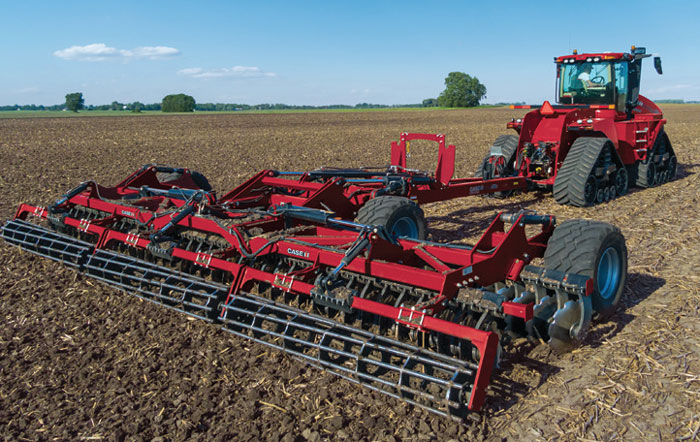
Case IH’s Speed-Tiller features a constant-level hitch to deliver deeper penetration and more consistent disc depth. Additionally, wing down pressure provides consistent penetration across the entire width of the implement, while indexed and independently mounted blades are designed to work every inch of the soil profile. Photo by: Case IH
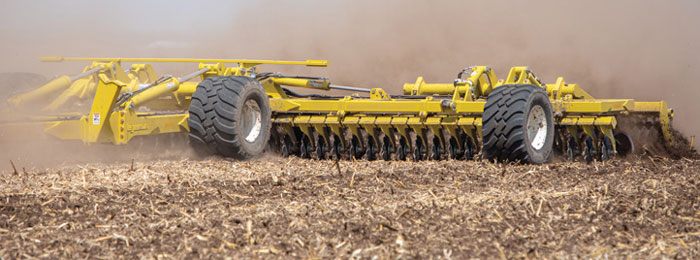
Degelman’s Pro-Till features shallow-face discs to eliminate compaction layers. Extra weight is built directly into the frame to help handle extreme soil and trash conditions. An exclusive furrow roller system helps create a field finish in a single pass. Photo by: Degelman
When you’re talking about “speed” in a more complete sense, however, some dealers like to keep the focus on discs. That’s because high-speed discs generally do a better job at inverting soil and burying residue thanks to 2 rows of discs, while still preparing a nice seedbed thanks to some kind of rear finishing tool. Discs can also work at lower depths than a VT tool, giving growers more versatility in both the fall and spring. So when you’re talking about “speed,” a high-speed disc can help save a lot of time in more ways than one.
“What I like about a speed disc is that it can be a lot of different things depending on how the farmer wants to use it,” says Jim Goodale, a territory manager for the upper Midwest for Versatile, a manufacturer of tractors and tillage equipment. “It could be used like vertical tillage to run fast and shallow, tickling the top to dry out the soil and manage a little bit of residue. Or, some farmers use it as primary tillage to run 4 or 5 inches deep under heavy fall residue. A third way I’ve seen speed discs used is to work at a medium depth of 2-3 inches, using it for soil prep for spring planting. A high-speed disc is really a tool that crosses all genres of tillage.”
Everyone’s a Prospect, Within Reason
Due to the potential boost in productivity, most dealers say anyone tilling a field is a good candidate for high-speed tillage. “There really isn’t an application around here that a high-speed disc doesn’t work well in,” says Clint Burgardt, owner of Dakota Truck & Farm in Minot, N.D.
Dakota Truck & Farm has been selling high-speed discs since it became a Versatile dealer in October 2020. The dealership sold a couple units in its first year and has sold 4 or 5 each of the past 2 years. Now the dealership is adding the Väderstad line in anticipation of an expanding market for this type of equipment.
“We see Väderstad adding to our sales, not taking away from our Versatile sales,” Burgardt points out. “Most of our customers are buying a 35- or 40-foot high-speed disc. The nice thing about the Väderstad product is it’s a smaller unit that can still be pulled by a larger front-wheel-assist tractor. That should open things up to more customers who don’t have a 500-horsepower tractor.”
Over in Oregon, Grauer says he’s sold high-speed discs to just about every type of grower in his area. “Once someone uses it, they realize how much it can cut down on their tillage practices,” Grauer says. He’s even sold to a couple dairies for working their cornstalks, grasses and cover crops. He has sold high-speed discs to growers looking to take out grass and wheat. “We’ve seen it become pretty popular across the board,” Grauer reiterates.
One challenge some dealers may face is the fact that the price of a high-speed disc is typically much higher than more traditional tillage equipment.
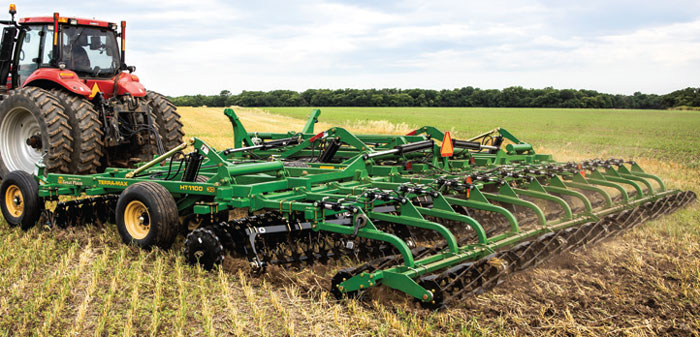
Great Plains’ HT1100 Terra-Max is available in widths from 40 feet down to 10, enabling lower-horsepower tractors to utilize this hybrid high-speed tillage tool. The front gangs adjust from 0-8 degrees, while the rear coulter gangs adjust proportionally from 0-6 degrees for adaptability in different soil conditions. Photo by: Great Plains
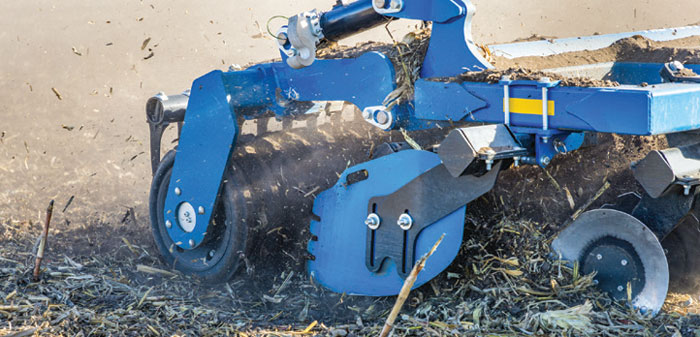
Kinze’s Mach Till is available in widths of 20-41 feet. All models feature shallow-face discs for a more aggressive cutting edge while eliminating compaction layers. A consistent working depth is maintained by distributing the frame weight wing-to-wing with a pressure-compensated hydraulic weight distribution system. Photo by: Kinze
“The higher upfront cost might knock 50% of your prospects out of the game right off the bat,” warns Tim Seubert, owner of S&S Equipment in Lawton, Iowa. Seubert started selling high-speed discs in 2016 with the Horsch brand. Then he added the Kinze line in 2018. S&S has gone from selling a few per year to roughly 8-10.
A large portion of Seubert’s high-speed disc sales go to larger farming operations. According to Seubert, these customers aren’t as susceptible to sticker shock because they are highly focused on covering as many acres in as little time as possible. The pure speed of a high-speed disc, coupled with the potential for one-pass tillage, can dramatically cut down on field time.
When you get down to it, that tremendous time savings is precisely why many smaller operators can eventually be coaxed past their initial sticker shock, too.
“We’re in an area (Northeast Ohio) where there are still plenty of 500-acre farms and first-time buyers,” Stannard relates. “Doing the most with one tool and in one pass is an advantage we spend a lot of time discussing with all of our customers.”
“More of our customers are looking for a ‘one and done’ type of solution,” Seubert adds, alluding to the concept that a high-speed disc can be an effective tool in both the fall and spring. “If that’s what you’re looking for, a high-speed disc works really well and is a really good investment.”
“We’re in an area where there are still plenty of 500-acre farms and first-time buyers. Doing the most with one tool and in one pass is an advantage we spend a lot of time discussing with all of our customers…” –Tom Stannard, Wellington Implement, Wellington, Ohio
As Burgardt touched on earlier, the horsepower needs of a high-speed disc can be another challenge to overcome. “You generally need at least 15 horse a foot, so you need a pretty good pony to pull one of these things,” Seubert says. “When you tell a grower who is used to pulling a 36-foot disc that they can only pull a 20-foot speed disc due to the size of their tractor, you might get a bit of a look.”
That’s where the conversation can turn back to ROI. “We like to explain how you can run this thing at 10 or 12 mph,” Asmus says. “So you’re still going to get a lot more acres done in less time — even with just a 20-foot speed disc.”
Defining Productivity
When articulating the productivity potential of a high-speed disc, it’s always important to start out by asking the customer what they are looking to accomplish. As Goodale pointed out earlier, a high-speed disc can do a lot of different things. “Once you know what that customer is looking to do, you can start going through the different settings and adjustments,” says Cal Medler, a sales rep at Dakota Truck & Farm.
Case in point, Medler was demoing a Väderstad high-speed disc on an unharvested soybean field that was full of kochia. Working at a 2-inch depth was leaving too much lay on top. “So we stopped and adjusted the machine down to a 3-inch cut so it could turn that soil a little better and get the residue covered up nicely,” Medler says. “Once we had it set up right, that field was ready to seed after one pass, and the customer was really impressed.
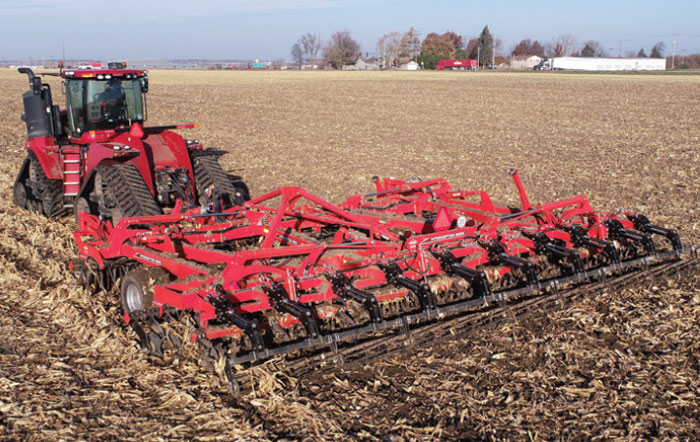
Kuhn Krause’s Interceptor 8055 features unique blades with 32 flutes that help reduce clod size. Blades are configured in a tandem layout to prevent tracking and ensure a more uniform distribution of soil and residue. Tines are then fitted behind the first rank of blades to initiate residue redistribution and soil leveling. Photo by: Kuhn Krause
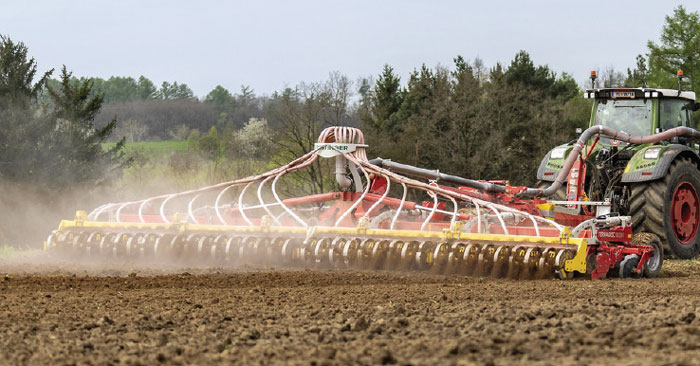
Pöttinger’s TERRADISC 8001 T and 10001 T Disk Harrows are designed with an aggressive disc angle and offset configuration to enhance penetration and the mixing of soil and vegetation. Additionally, two solid forged carrier arms are welded to a wide clamping bracket, ensuring that the discs always retain their position and angle. Photo by:Pöttinger
“You can also gradually get to the right speed for what you’re doing,” Medler continues. “Speed can make a big difference. Some high-speed discs need 10 or 12 mph to work correctly. Some can do a better job at 8 or 9 mph. It’s about finding the right balance and explaining that to the customer.”
So long as they have the tractor to pull it, Burgardt says some no-till farmers will also show some interest in a high-speed disc. Going no-till for too long might result in too much residue in the field, which starts to affect seed accuracy and yield. The concept of a fast, productive, one-pass tool can present an appealing first step back into tilling, he says.
Grauer says many of the high-speed discs out there are still most effective as two-pass tools. But still, a significant productivity gain is to be had compared to more conventional tilling methods. “By using a high-speed disc, we’ve personally been able to cut out 2 or 3 passes from our own farming operation,” Grauer points out.
Some of Grauer’s customers have also found that one pass is indeed all it takes. Take those dairies, for instance. “They’ll go 4 or 5 inches deep and grind that corn residue into nothing,” Grauer says. “Then, they’ll go right back in with annual rye or sudangrass. Instead of 4 passes — one with a plow, discing twice and leveling with a harrow — the high-speed disc gets everything buried and perfectly level so it’s one and done. That saves an incredible amount of time.”
Along with discussing time savings, Stannard likes to eventually turn his sales conversations to yield. “Tilling is really just planning ahead for the planter,” he says. “Too rough a surface layer, or even a rough couple of inches below the surface, can affect seed placement, which will ultimately impact yield. It doesn’t take much improvement to really add up. An extra bushel or two an acre can make a huge difference and help pay for a high-speed tool pretty quickly.”
Seubert’s sales pitch typically hones in on the number of passes, i.e. two vs. one. Then he talks to the customer about how many acres they’re managing. Obviously, more acres means more time saved, and a shorter payback. “Even those managing a smaller amount of acres, I don’t see the payback taking more than a few years,” Seubert says. “And these high-speed discs are heavy-duty machines that are going to last a long time. They’re a good investment.”
The Devil’s in the Details of the Demo
The dealers interviewed for this article all agree that a good demo is key to selling high-speed tillage — emphasis on the word good. Out in Iowa, Seubert says he actually ends up selling a high-speed disc on 80% of the demos he performs. It’s all about the planning to make sure the customer experiences what they’re looking to experience.
Step one: Make sure you have enough tractor. “You never want to go out on a demo and find out that the customer doesn’t have a tractor that can pull a speed disc,” Grauer says. “If we have to pull our own tractor out there to do the demo, we will. And sometimes, you might even end up selling a speed disc and a tractor.”
It’s also important to prepare the customer who’ll be doing the demoing. As Stannard points out, a high-speed disc isn’t a “set it and forget it” type of tool that any novice operator can immediately get the hang of.
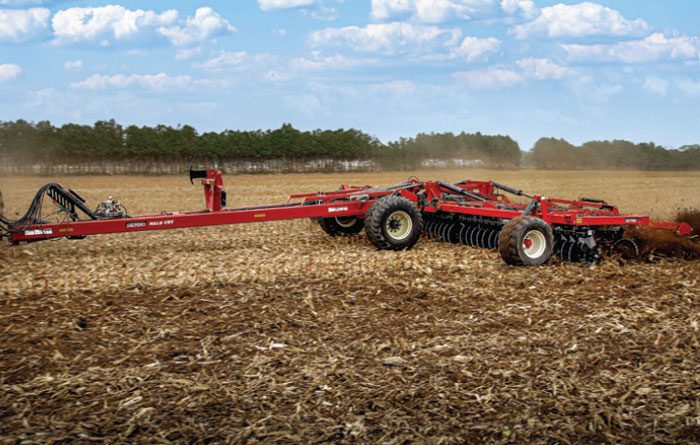
Salford’s HALO VRT allows for blade angles from 2-15 degrees, enabling it to perform like either a vertical tillage tool or tandem disc, at fast speeds up to 14 mph. Additionally, the frame’s hydraulic system is engineered to prevent “hopping,” further enhancing this tool’s productivity and finished field quality. Photo by: Salford
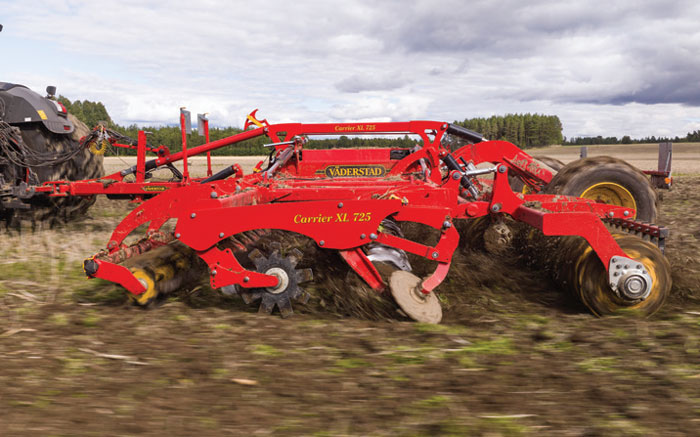
Väderstad’s Carrier XL 425-725 is available in working widths from 13.9 to 23.8 feet. It can be fitted with 20- or 24-inch discs with adjustable angles from 11-17 degrees to maximize performance and versatility, allowing it to be used for either primary tillage or seedbed preparation. Photo by: Väderstad
“If the desired results aren’t achieved, you’ll either have to go back with another pass, or you’re really going to screw things up for that planter pass in the spring,” he says. “It’s really important to carefully go over how to set up the machine. It’s also really important to have someone at the demo who can help answer questions and keep an eye on things.”
“Because a speed disc will go into the ground so well, a lot of people want to use it as primary tillage,” Grauer adds. “We’ve found that a lot of new users want to yank out all the stops, drop it in the ground 6 or 8 inches and make their first pass. The machine can do that, don’t get me wrong. The problem is that when you go over it the next time, the blades may want to plug up because they’re going so deep and have nothing to bite into. So you have to educate the operator that this is a chopping and incorporating tool and that you go down in stages. If the customer wants 6 inches of fluffy duffy, the machine can do that. But it’s better to go 3 and 6, as opposed to 6 and 6.”
Over in Nebraska, Asmus always likes to ask the customer how deep they’re looking to go. Then he shows them how to set the equipment up to do that. “Sometimes we’ll even adjust the depth as we’re demoing to see some of the differences,” Asmus says. “With a high-speed disc, we might raise and lower the rear finishing tool to show what a difference that can make, too.”
Asmus also likes to use his demos to generate some additional buzz. He’ll often take a few videos that his wife, Shelby, posts to their social media accounts, namely Facebook. Seeing is believing with a high-speed disc, and videos can help capture people’s attention and get them talking.
Renting can be another way to put more units into the field to generate more interest. More importantly, renting provides a way to begin converting customers to high-speed tillage who are just too overwhelmed by that initial sticker shock.
“I’ve actually ended up selling a few speed discs this way,” Seubert relates. “I encourage the customer to rent one and maybe use it on a portion of the acreage they’re managing. We feel the ROI is there due to the speed, coverage and smoothness of the ground. We also feel speed disc is a one-pass tool.
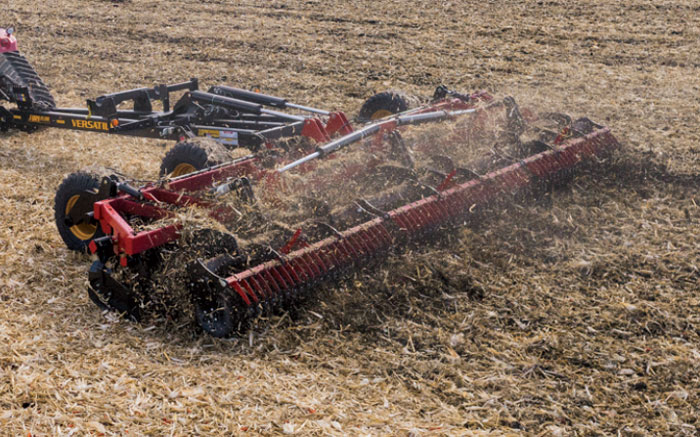
Versatile’s Fury HS uses an aggressive 20 degree disc angle and wide range of working speeds up to 12 mph to provide a superior field finish. These discs are also engineered to have a high weight-per-foot ratio which helps handle hard or dense soils. Photo by: Versatile
"But you can also talk about yield. Most combines being used today have some kind of yield monitor on them. That lets the customer see if there’s going to be an ROI from a yield standpoint, as well. From what I’ve seen, there typically is.”
Once a grower sees that complete ROI potential, they’re typically ready to give high-speed tillage a serious look. It’s the dealer’s role to help them see that potential, and then see what the equipment can actually do in the field to help accomplish their objectives.





